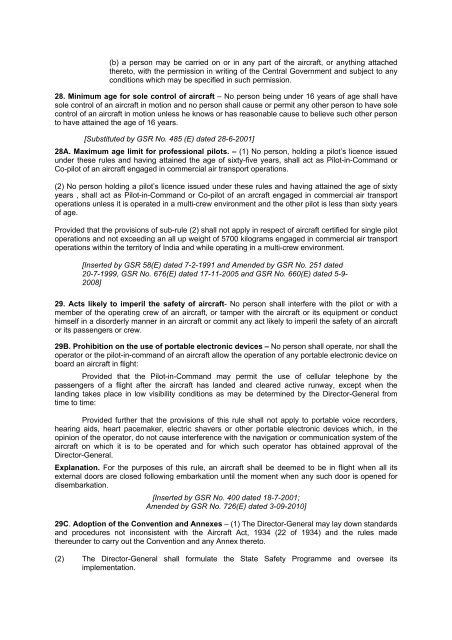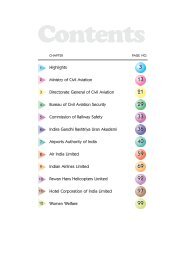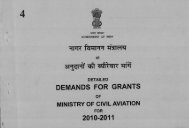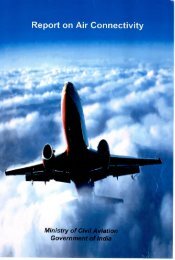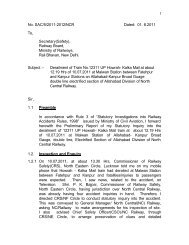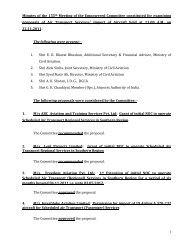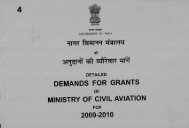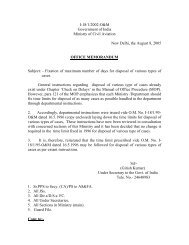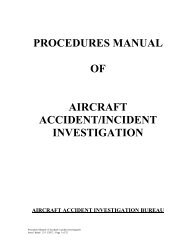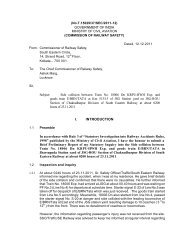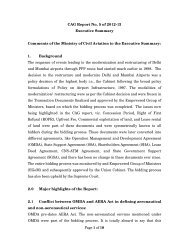THE AIRCRAFT RULES, 1937 - Ministry of Civil Aviation
THE AIRCRAFT RULES, 1937 - Ministry of Civil Aviation
THE AIRCRAFT RULES, 1937 - Ministry of Civil Aviation
Create successful ePaper yourself
Turn your PDF publications into a flip-book with our unique Google optimized e-Paper software.
(b) a person may be carried on or in any part <strong>of</strong> the aircraft, or anything attachedthereto, with the permission in writing <strong>of</strong> the Central Government and subject to anyconditions which may be specified in such permission.28. Minimum age for sole control <strong>of</strong> aircraft – No person being under 16 years <strong>of</strong> age shall havesole control <strong>of</strong> an aircraft in motion and no person shall cause or permit any other person to have solecontrol <strong>of</strong> an aircraft in motion unless he knows or has reasonable cause to believe such other personto have attained the age <strong>of</strong> 16 years.[Substituted by GSR No. 485 (E) dated 28-6-2001]28A. Maximum age limit for pr<strong>of</strong>essional pilots. – (1) No person, holding a pilot’s licence issuedunder these rules and having attained the age <strong>of</strong> sixty-five years, shall act as Pilot-in-Command orCo-pilot <strong>of</strong> an aircraft engaged in commercial air transport operations.(2) No person holding a pilot’s licence issued under these rules and having attained the age <strong>of</strong> sixtyyears , shall act as Pilot-in-Command or Co-pilot <strong>of</strong> an arcraft engaged in commercial air transportoperations unless it is operated in a multi-crew environment and the other pilot is less than sixty years<strong>of</strong> age.Provided that the provisions <strong>of</strong> sub-rule (2) shall not apply in respect <strong>of</strong> aircraft certified for single pilotoperations and not exceeding an all up weight <strong>of</strong> 5700 kilograms engaged in commercial air transportoperations within the territory <strong>of</strong> India and while operating in a multi-crew environment.[Inserted by GSR 58(E) dated 7-2-1991 and Amended by GSR No. 251 dated20-7-1999, GSR No. 676(E) dated 17-11-2005 and GSR No. 660(E) dated 5-9-2008]29. Acts likely to imperil the safety <strong>of</strong> aircraft- No person shall interfere with the pilot or with amember <strong>of</strong> the operating crew <strong>of</strong> an aircraft, or tamper with the aircraft or its equipment or conducthimself in a disorderly manner in an aircraft or commit any act likely to imperil the safety <strong>of</strong> an aircraftor its passengers or crew.29B. Prohibition on the use <strong>of</strong> portable electronic devices – No person shall operate, nor shall theoperator or the pilot-in-command <strong>of</strong> an aircraft allow the operation <strong>of</strong> any portable electronic device onboard an aircraft in flight:Provided that the Pilot-in-Command may permit the use <strong>of</strong> cellular telephone by thepassengers <strong>of</strong> a flight after the aircraft has landed and cleared active runway, except when thelanding takes place in low visibility conditions as may be determined by the Director-General fromtime to time:Provided further that the provisions <strong>of</strong> this rule shall not apply to portable voice recorders,hearing aids, heart pacemaker, electric shavers or other portable electronic devices which, in theopinion <strong>of</strong> the operator, do not cause interference with the navigation or communication system <strong>of</strong> theaircraft on which it is to be operated and for which such operator has obtained approval <strong>of</strong> theDirector-General.Explanation. For the purposes <strong>of</strong> this rule, an aircraft shall be deemed to be in flight when all itsexternal doors are closed following embarkation until the moment when any such door is opened fordisembarkation.[Inserted by GSR No. 400 dated 18-7-2001;Amended by GSR No. 726(E) dated 3-09-2010]29C. Adoption <strong>of</strong> the Convention and Annexes – (1) The Director-General may lay down standardsand procedures not inconsistent with the Aircraft Act, 1934 (22 <strong>of</strong> 1934) and the rules madethereunder to carry out the Convention and any Annex thereto.(2) The Director-General shall formulate the State Safety Programme and oversee itsimplementation.


